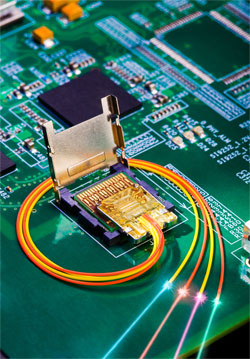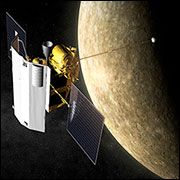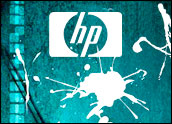
Intel is turning on the lights, but without light. The chip maker will use copper instead of fiber in its new Light Peak optical interconnection technology, reaching speeds surprisingly better than the company expected, Intel architecture group director David Perlmutter said in a Friday interview with IDG News Service at CES.
The copper achieved data transfer speeds of 10 Gbps, Perlmutter said. More expensive fiber optics won’t come for a while, but will reportedly take Light Peak to 100 Gbps.
“There could be several reasons for the delay, but I would suggest that the primary reason is cost,” said Asif Anwar, director of the strategic technologies practice for Strategy Analytics and an expert in fiber-optics.
“While fiber-optic components are getting cheaper, the fact that we have not seen a major announcement from an Apple or a Sony impedes the ability of the Light Peak technology to get traction in the marketplace, and aid in the maturation of the technology,” Anwar told TechNewsWorld.
Meanwhile, Intel will get started at a reasonable speed.
“I think Intel wanted 10 Gigs of transfer from Light Peak. That is doable on copper, but not trivial,” Frost & Sullivan telecommunications analyst and program manager Michael Jude told TechNewsWorld. “But when higher transfer rates are desired, copper starts looking a lot like a radio antenna, with all sorts of issues.”
Tower of Cable
Designed to replace, in a single technology, an interconnection Tower of Babel — er, Tower of Cable — piled with Firewires, USBs and Ethernet cords, Light Peak has had backers from Apple to Sony looking for a universal, light-speed connection to move data to and from tablets, notebooks, smartphones and other gadgets.
Last year, Apple suggested it might introduce a line of Light Peak Macs. Intel also showed developers how the technology could connect peripherals, workstations, displays, disk drives and docking stations over a single port and cable.
Along with zipping up its speed, the optical technology is supposed to reduce Light Peak’s footprint, with smaller connectors and thinner cables. It’s also greener — optical interfaces don’t radiate electrical and magnetic fields, and they’re easier on battery life.
However, that’s all on hold for now. Instead of speeding photons over optics, Light Speed will stay in the slow lane, moving electrons through copper, and staying well below the threshold speeds — 25 Gbps, 50 Gbps, and up — beyond which copper fails.
“I would guess that making Light Peak work has been somewhat more challenging than they originally thought,” said Frost & Sullivan’s Jude. “Optical-electric handoffs require some exotic electronics, and it may be that it is simply taking longer to fabricate the devices than they thought.”
Copper Isn’t Tops
Call it Light Peak 1.0, said SA’s Anwar: “Intel is using copper technology as a means of market entry,” he said. “Copper is capable as evidenced by the use of copper in HDMI cables, and can achieve speeds of up to 10 Gbps. But Intel’s eventual goal of 100 Gbps will require fiber.”
The copper substitution, Anwar explained, “allows Intel to enter the market at a relatively lower price point.”
Light Peak can then penetrate a wider application base, he suggested. “This approach will ensure that the technology becomes entrenched in the consumer electronics market.”
Beside the lower price, entering the market prematurely — sans optics — “creates some buzz, gets manufacturers thinking in terms of the new interface, and gives Intel some time to get the opto-electronics right,” Frost & Sullivan’s Jude explained.
That buzz has Light Peak “now being touted as a protocol that will be used to underpin native protocols such as PCI Express, Display Port and USB, rather than displacing these protocols,” Anwar explained. “But Intel still needs to get a ‘foot-in-the-door’ if Lightpeak is to become a de facto standard and gain mass market acceptance.”
Intel representatives did not respond to TechNewsWorld’s questions by press time.






















































